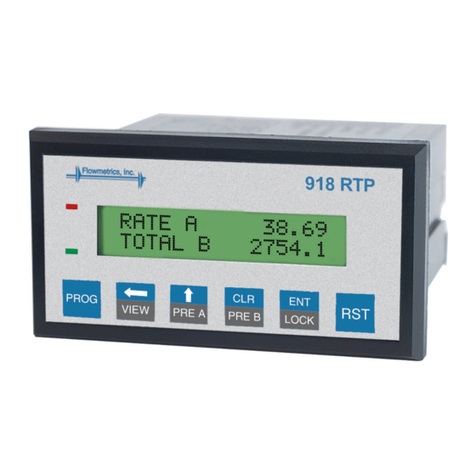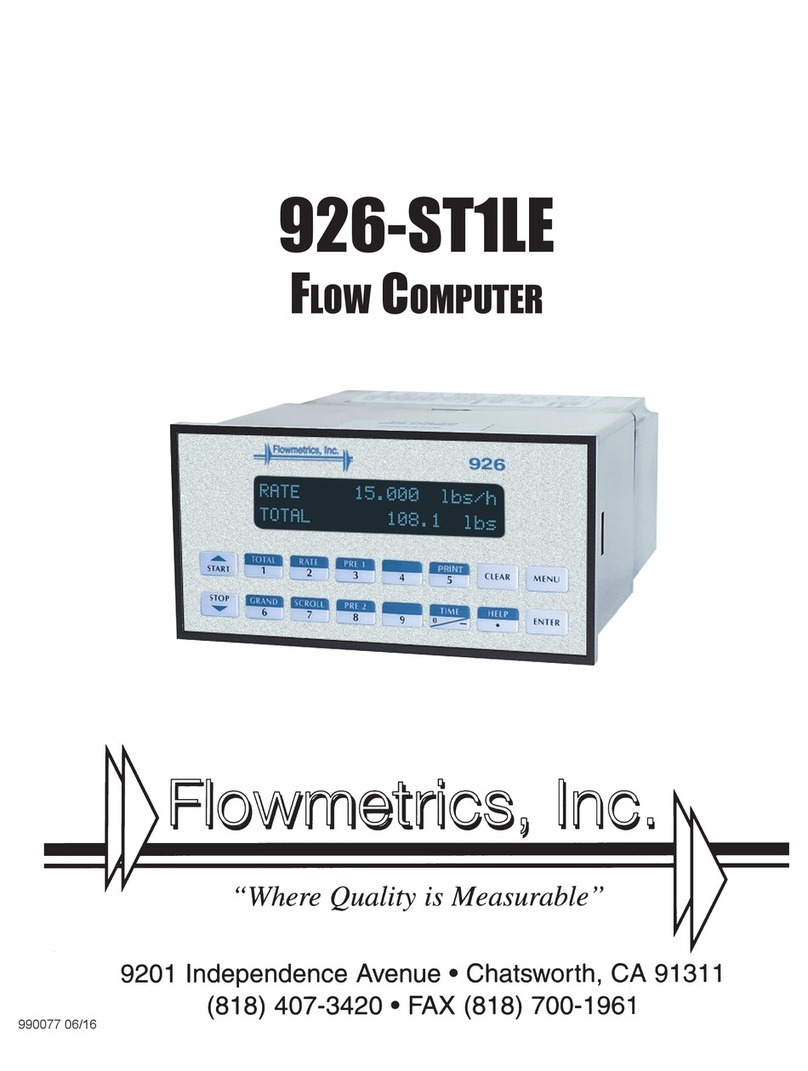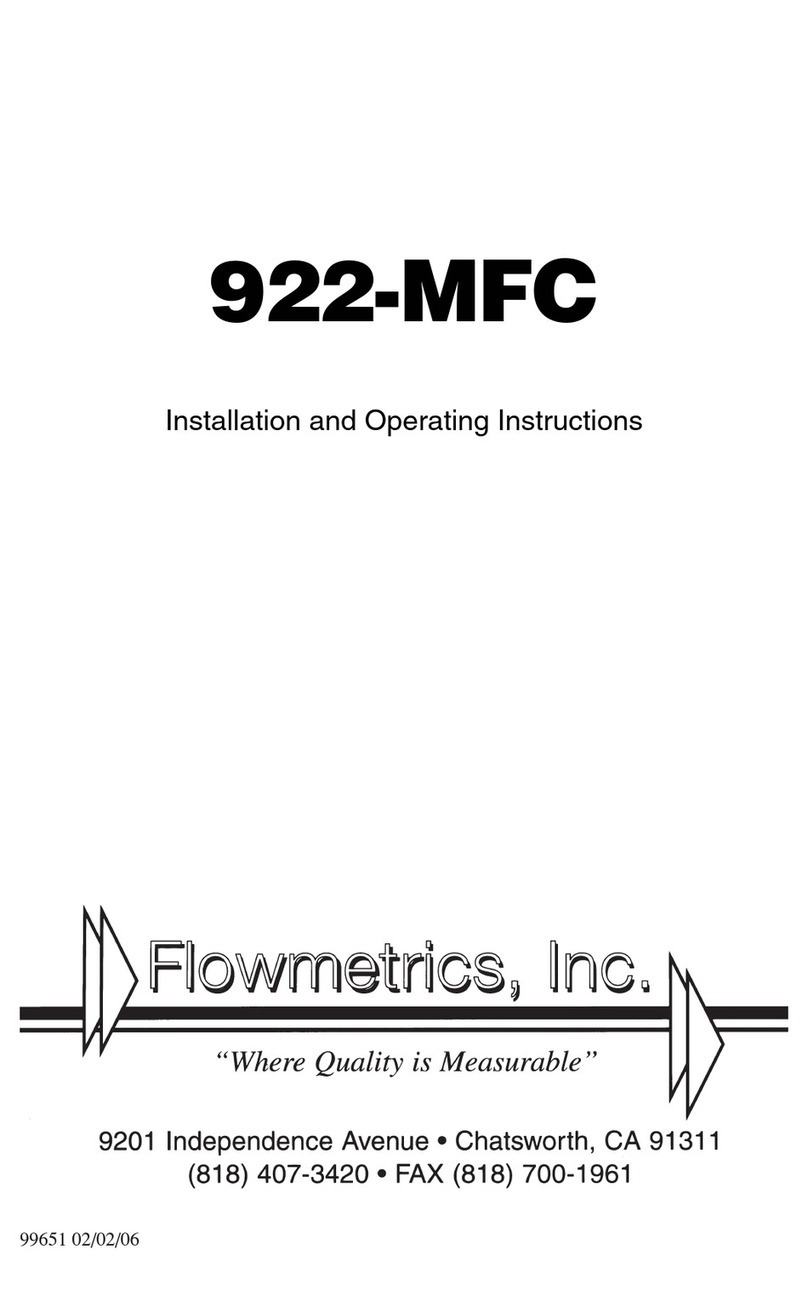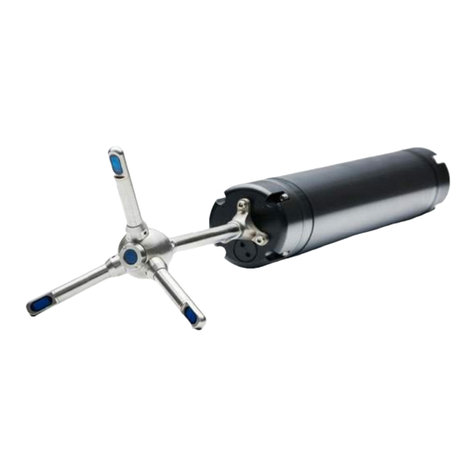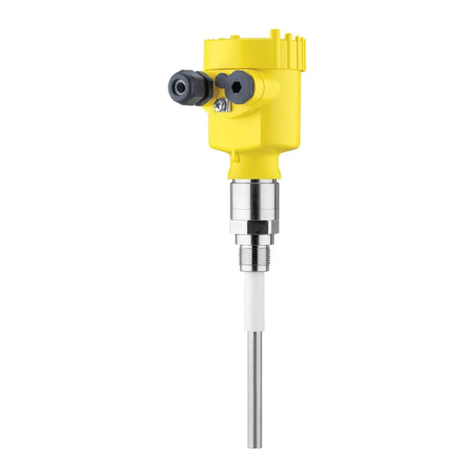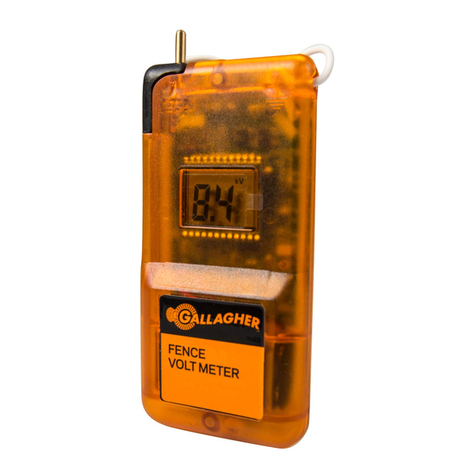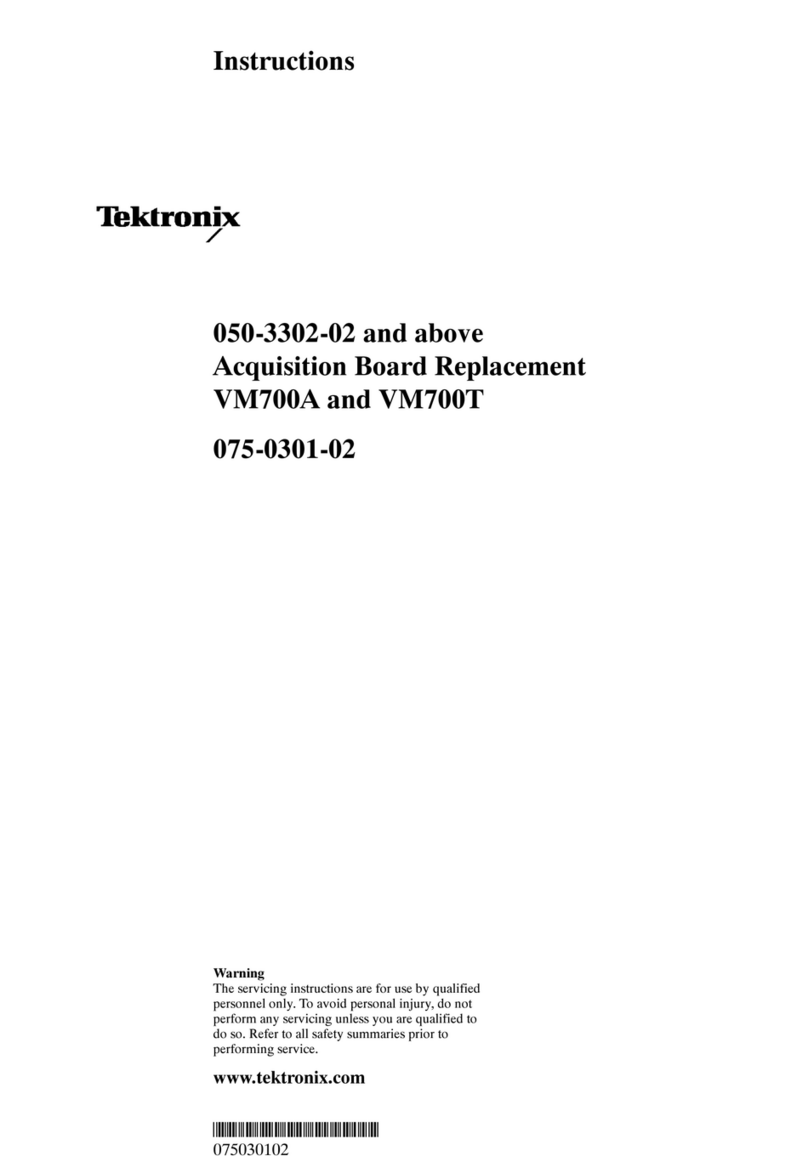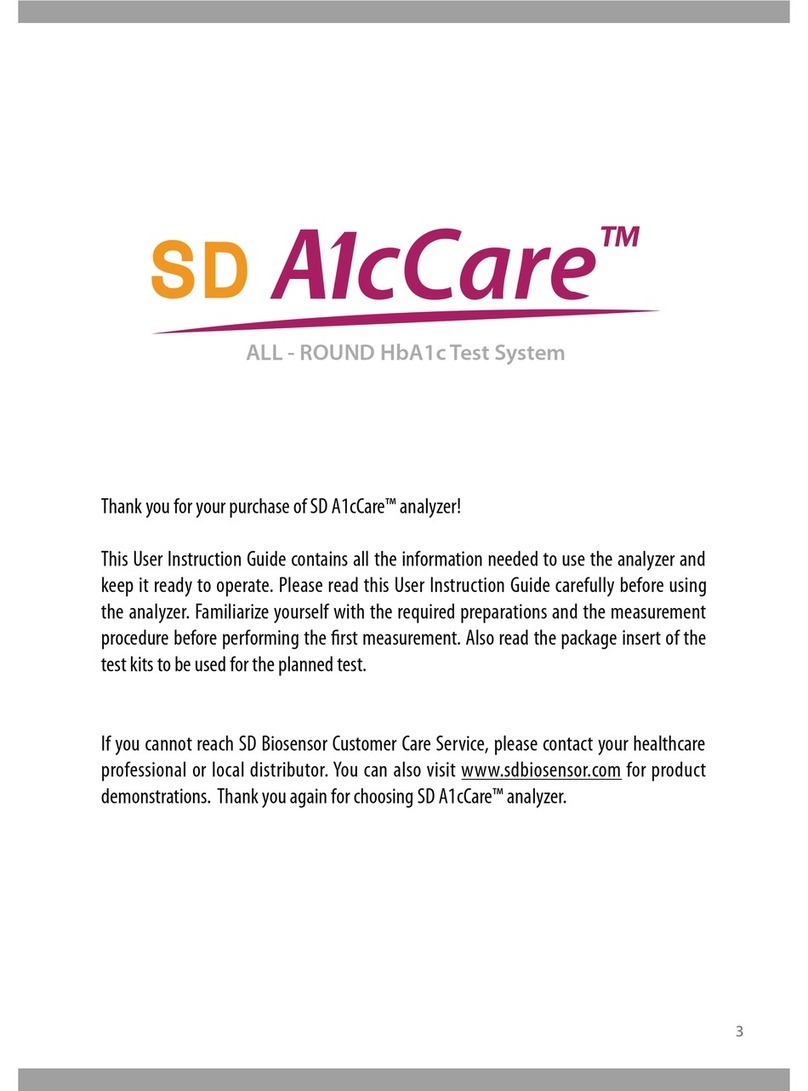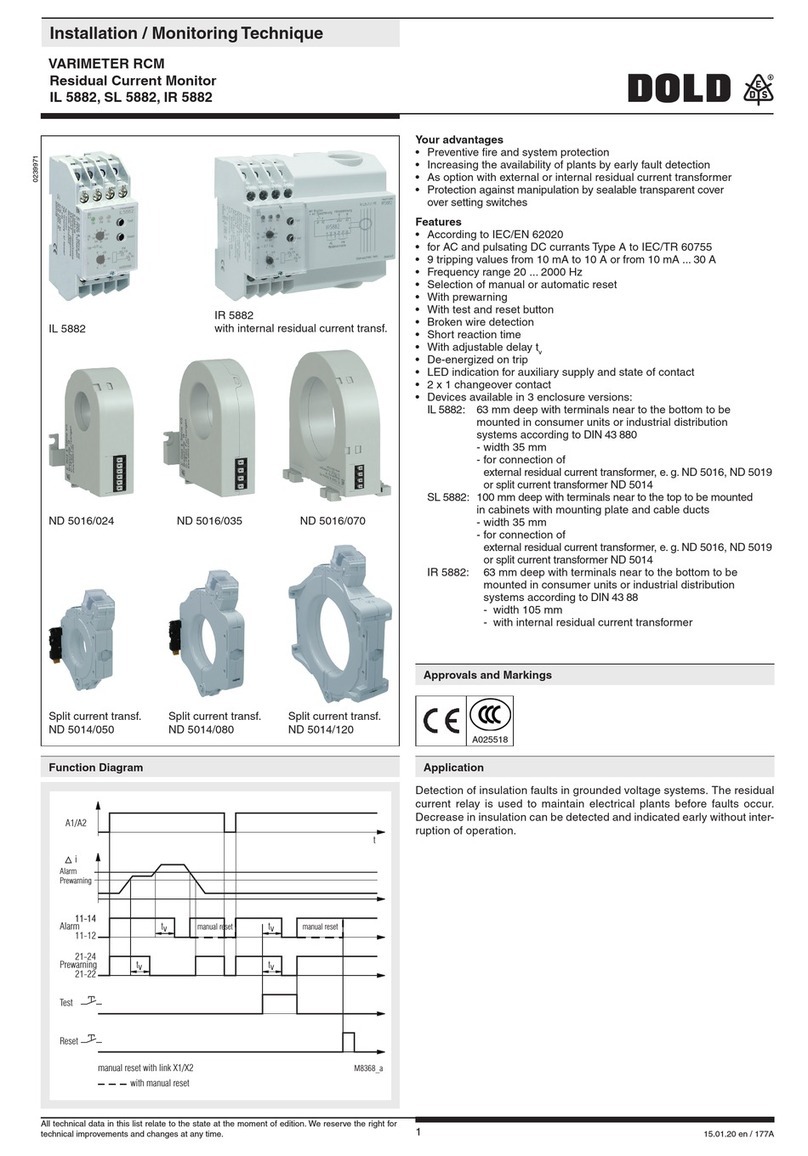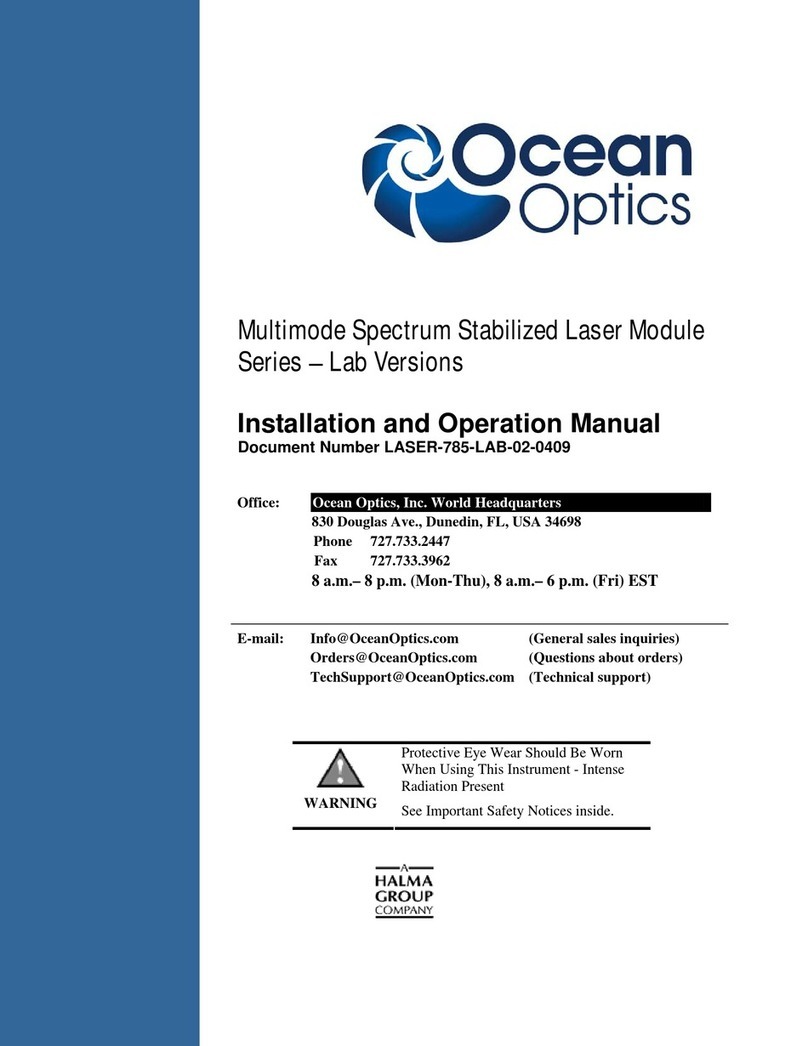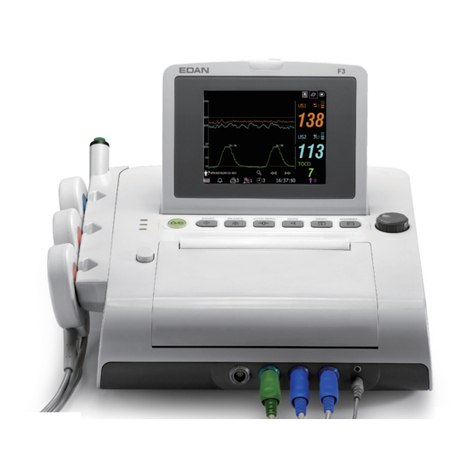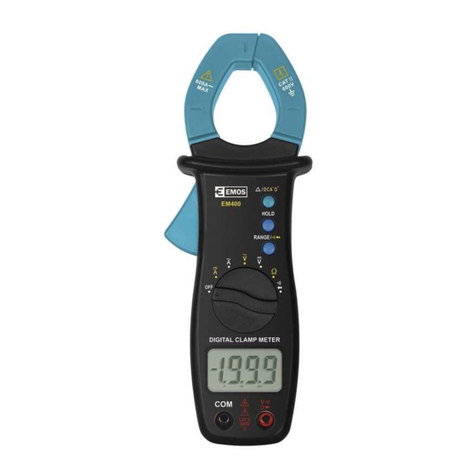Flowmetrics 913 DRT Manual

913 DRT
DUAL RATE / TOTALIZER
INSTALLATION & OPERATING INSTRUCTIONS
99827 08/27/01

SPECIFICATIONS ..................................................................................................1
DECODING PART NUMBER..................................................................................2
HOW TO MOUNT THE UNIT..................................................................................3
WIRING 913 DRT ...................................................................................................4
TYPICAL HOOKUPS ...............................................................................................5
WHAT CAN YOU VIEW ..........................................................................................6
OUTPUT JUMPER SELECTIONS..........................................................................6
MILLIVOLT INPUT OPTION JUMPER SELECTIONS............................................6
OPERATING FRONT PANEL.................................................................................7
PROGRAMMING FLOW CHART ...........................................................................7
PROGRAM CODES & DESCRIPTIONS ................................................................8
913 DRT TERMINATIONS......................................................................................10
CALCULATING SCALE FACTORS ........................................................................11
913 DRT PROGRAMMING PROCEDURE.............................................................12
SETTING SCALING FACTORS..............................................................................12
SETTING THE COUNTER......................................................................................13
SETTING THE RATE..............................................................................................14
SETTING THE LOCK CODE & LOCKING THE UNIT ............................................15
SETTING THE RELAYS & PRESETS ....................................................................16
OUTPUT WIRING ...................................................................................................18
ANALOG OUTPUT OPTION...................................................................................19
RS232/RS422 SERIAL COMMUNICATIONS.........................................................20
TROUBLESHOOTING GUIDE................................................................................23
WARRANTY ............................................................................................................24
TABLE OF CONTENTS

1
DESCRIPTION & SPECIFICATIONS
DESCRIPTION:
The 913 DRT (Dual Rate Totalizer) is a dual 5 digit Ratemeter 6
digit Totalizer in a 1/8 DIN package. User selects 1 of 6 displays to
show A,B or C rate and A,B or C total. Inputs A and B have
separate scaling to read in engineering units.
A 4-20mA (0-20mA) output of the C rate or total is optional.
The user can press the VIEW button to see 6 separate items
total A, total B, total C, rate A, rate B, rate C. Negative values are
displayed with a negative symbol ( -
12345
). For the C value, the
user can choose from the following combination of A&B inputs:
TOTAL; with a choice of A+B or A-B; RATIO with choice of
A÷B(x100) to show percent of A to B quantity or A÷[A+B(x100)] to
show percent of A to total quantity.
Two independent presets are standard. User selects whether out-
put A is activated by total or rate value of input A or selected C.
Output B can be activated by total or rate value of input B or
selected C. Outputs activated by A or B total can be set to latch or
autorecycle with an adjustable output duration from 00.1 to 99.9
sec. For rate, ratio, or C total outputs pull in when value is equal or
above the preset and drop out when value is below the preset
minus the selected 0 to 999 hysteresis.
SPECIFICATIONS:
DISPLAY
6 digit, 0.55" High LED
INPUT POWER:
110 VAC ±15% or 12 to 15 VDC
220 VAC ±15% or 12 to 15 VDC
24 VAC ±15% or 12 to 15 VDC
CURRENT:
250 mA DC max. or 6.5 VA AC
OUTPUT POWER (AC powered units only)
+12 VDC @ 50 mA, unregulated -10 + 50%
TEMPERATURE:
Operating:
+32°F (0°C) to +130 F (+54°C)
Storage:
-40 F (-40°C) to +200°F (93°C)
MEMORY
EEPROM stores data for 10 years if power is lost.
INPUTS:
3: High Impedance DC pulse input 4-30 VDC (high), Open or 0-
1 VDC (low),10 KΩimp. 10 kHz max. speed. Accepts simul-
taneous inputs. May be used with KEP 711 series or PD & D
series sensors.
3M: Mag. Input, Input A only, accepts 30mV input (50 V max. P/P)
signals 10 KΩimp. 5 kHz max. (Input B, 4-30V)
3MB: Mag. Input, Inputs A & B, accepts 30mV input (50 V max. P/
P) signals 10 KΩimp. 5 kHz max.
NOTE: The Mag. inputs have filtering as follows: up to 300hz
@30mV, 5KHz @ .25V to 50V max.
RESET:
Front Panel: Resets displayed value and control output
Remote: 4-30 VDC negative edge resets all counters,
"A" counter or "B" counter (user selectable).
K FACTOR/SCALING
The 913 DRT has two separate K-Factors that are used to convert
the input pulses to engineering units. The 5 digit K-Factor dividers,
with decimal keyed into any position, allow easy direct entry of any
K-Factor from 0.0001 to 99999. Separate factors may be entered
for the 2 separate input channels.
CONTROL OUTPUTS:
Relays:
2 each N.O. Relay; 10 Amps120/240 VAC or 28 VDC.
(N.C. relay contacts and NPN transistor output
available with solder jumpers. Transistor output is
internally pulled up to 10 VDC through relay coil, sinks
from 10 VDC to .5 V @ 100 mA)
Analog Output:
An optional 4-20mA (0-20mA) output is available for
the 913 DRT. The output can be programmed
to track rate or total of the C display. This feature is available
by adding suffix A to the part number. Connections are
via a 2 terminal pluggable screw connector.
Programming is accomplished by using the front panel
in conjunction with rear dip switches.
Accuracy: 50uA worst case.
Compliance Voltage: 3 to 30 VDC non inductive.
RS232/RS422SERIAL INTERFACE
If the serial interface option is supplied, up to 99 units can be linked
together. (The terminal addressing the unit must be capable of
driving all loads in the loop.) Unit status and new set points can be
communicated by serial communication. Mode changes, however,
must always be made on the front panel. Data is transmitted at
selected baud rates using standard seven bit ASCII characters and
parity with two additional bits of “Start” and “Stop” to make up the
standard ten bit character.
Data is received and transmitted over standard EIA RS232 or
RS422 levels. Each 10 bit character is made up of a start bit, 7 bit
ASCII code, parity bit and stop bit. Unit number, baud rate and
parity are entered in the “Program Setting” set up mode and remain
in memory even if power is off.
Note that the input impedance of RS232 is 3K or 7K Ohm worst
case. The terminal addressing the unit must be capable of driving
all loads in the loop. RS422 input impedance is much higher and
there is usually no problem driving 25 units. Unit serial transmit line
remains in a high impedance “OFF” state until addressed.
PRESETS
Two control outputs are provided. To set relay values, press “menu”
button until “Relay” appears on the display, the Aand B outputs can
be assigned to theA,B or C displays. A5 digit value can be entered
for both presets and the decimal point location is the same as the
counter. The outputs can be set to energize from 0.1 to 99.9
seconds or latch (0.0). If a value other than 0.0 is entered, the
counters will auto reset at the preset (for A&B counters).

2
Example: 913 DRT A 3 A
Series:
913 DRT= 6 digits counter, 5 digit ratemeter
with presets and scaling.
Operating Voltage:
A= 110 VAC ±15% or 12 to 15 VDC
B= 220 VAC ±15% or 12 to 15 VDC
C= 24 VAC ±15% or 12 to 15 VDC
Count Inputs:
3 = Standard, 4-30 VDC simultaneous inputs.
3M = Mag. Input, Input A only, 30mV input
(Input B, 4-30V)
3MB = Mag. Input, Inputs A & B, 30mV input
Options
1= RS232 Communications
2= RS422 Communications
A= Analog Output (4-20/0-20 mA)
CE = CE Approved Version
NOTE: RS232/RS422 & Analog Output options can not be combined
DECODING PART NUMBER
LOCKOUT
Unauthorized front panel changes can be prevented by entering a
user selected 5 digit code. The front panel can be completely
locked out or the presets can remain accessible.
RATEMETER
Accurate to 4 1/2 digits (±1 display digit). The ratemeter uses 1/tau
with 8 digit math, can sample from 2 to 24 seconds maximum, and
auto-range up to 5 digits of significant information. In the “RPS”
mode, the ratemeter displays in units per second, and in the
“scale” mode, units per hour or per minute. The unit will display the
rate of the A&B Inputs.
COUNTER
The two 6-digit counters can count at 10Khz speed. Each has a
seporate 5-digit dividing scale factor. The counters advance on the
positive edge of each pulse. Besides being able to step through the
total and rate values of A & B inputs, the user can see a selected
combination of total or rate of A+B, A-B, A÷BX100 (percent of A to
B), A÷A+BX100 (percent of A to total). A negative display will be
veiwed as a 5 digit display with a negative symbol ( -
12345
).
SPECIFICATIONS
(continued)

3
HOW TO MOUNT THE UNIT
The unit is designed to be mounted with a gasket providing a water tight seal. Two mounting brackets are provided to
secure the unit to the panel. A panel less than .1" may distort if the clamps are screwed too tightly.
Slide the body of the unit through the rubber gasket. Insert the unit into the panel. As shown in "FIG. A", slide the brackets
up the groove to press against the back of the panel. Insert screws into rear of brackets and tighten them evenly and
alternately. Do not over tighten! A normal level of torque is required. Maximum torque should be 3" pounds.
This product is designed to be panel mounted and is NEMA 4 rated if proper mounting procedures are followed and the
required and supplied hardware is correctly used.
If the panel in which the unit is mounted is less than .125 of an inch thick, the possibility exists that there will be some
flexing. Should this flexing occur, the resulting deformation of the panel could cause a loss of the water tight seal. In case
this should occur, the use of silicone or other sealant would be recommended.
This product is designed to the NEMA 4 rated. However, the fact that we are unable to control either the location in which
the device is installed or the actual installation itself requires that the company's liability shall extend only to the repair or
replacement of a defective product.
We are prepared to offer additional assistance in those special situations where normal mounting methods do not seem to
satisfy the customers needs. This assistance may be obtained by calling the factory and asking for Application Engineer-
ing.
DIMENSIONS
3.622
(92)
1.772
(45)
4.437
(112.7)
2.625
(66.68)
0.587
(14.91)
4.245
(107.8)
BEZEL
GASKET
CUSTOMER PANEL
Panel Thickness 0.062" (1.5)
to 0.187" (4.7) max.
3.925
(99.7)
FIG A

4
WIRING THE 913 DRT
The rear terminal contains 12 screw terminals for connecting #14 to #28 gauge wire.
The unit is controlled by a microprocessor and, therefore, an electrically "noisy" environment could cause operating
problems. The input power line should not be common to power lines for motors, pumps, contactors, etc.
The unit is designed to be immune from line or RF voltage interference. In some environments voltage spikes of over 100
volts, even 1000 volts, can occur. When common to a power line driving motors voltage fluctuations can be extreme and
rapid. Lines driving DC or AC solenoids, relays, or actuators can also cause problems.
Four sources of noise can occur:
1) AC power line noise - If the unit cannot be connected to a clean power source, an inductive load suppressing device
(MOV as GE # V130LA1 or Resistor Capacitor as Paktron # .2 uf/220 ohm @ 400V) can be installed. Although locating
the suppressor across the AC supply at the unit should help, best results are obtained by connecting the suppressor
across the leads of the "load" at the device causing the spike.
2) Input line noise -The noise is carried on the input and D.C. ground lines. Make sure the input wires are never run into
the unit in a bundle with power input lines. Also, keep these input lines isolated from inductive lines from devices
drawing heavy loads. If there is a possibility of electrical noise, we recommend using shielded cable, with the shield
being hooked to the D.C. ground terminal on the instrument, and to "earth" at one point in the circuit, preferably at the
D.C. ground terminal of the unit.
3) Output lines - The unit has two relay outputs. When these outputs are used to run external relays or solenoids, spikes
can be generated upon activation. This noise can spread through the instrument causing operating problems. If the
source is a D.C. operated device, a general purpose diode (IN4004) placed across the solenoid prevents electrical
noise spikes. Connect the cathode (banded side) to the more positive side of the coil. If the source is an A.C. operated
device, use a MOV or Resistor Capacitor across the coil.
4) 12 VDC output supply - Noise can be generated on the 12 VDC output supply if it is used to drive inductive loads or if
the current draw exceeds 50 mA. Insure that all inductive loads have a diode (such as IN4004) across the coil and that
the current does not exceed 50 mA.

5
CONNECTING AC / DC POWER
NOTE: Connect power only after other connections are finished. Do not touch the live AC power terminals! The unit has
been designed with an isolated AC input. Thus, polarity is not a concern for the AC input. The chassis is plastic, therefore
earth ground is not used. For D.C. operation, connect + 12V to pin 7 and - D.C. to pin 8.
CONNECTING SENSOR INPUTS
These diagrams show how to hook typical input sensors to the unit. The unit supplies an unregulated 12 Volt (50mA)
output to power these sensors (Pin 7).
A valid pulse is one which makes a transition from the off-state (0 to 1V) to the on-state (4 to 30V): a positive going edge.
The input impedance is 10K Ohms to ground. The unit can be programmed from the front panel for slow switch closure
inputs up to 40Hz (select "Lo CPS"), or solid state switches (select "hi CPS") up to 9.99KHz. No rear terminal jumpers are
required. Use PNP (sourcing) type pulsers.
1 COMMON
2 N.O. (N.C./NPN)
3 COMMON
4 N.O. (N.C./NPN)
5 A INPUT
6 B INPUT
7 12 V OUTPUT/ + DC INPUT
8 - DC (GROUND)
9 RESET INPUT
10 NOT USED
11 AC INPUT
12 AC INPUT
COUNT
POWER
GROUND
COUNT
GROUND
POWER
A
RELAYS
B
*
* PULLUP RESISTANCE
4.7K TYPICAL
GND
+12V
STRIPCHART
RECORDER
TURBINE FLOWMETER
PULSE OUTPUT
PULSE OUTPUT
-
+
1- COMMON
2- N.O.(N.C./NPN)
3- COMMON
4- N.O.(N.C./NPN)
5- A INPUT
6- B INPUT
7- 12VDC OUT/+DC IN
8- -DC (GROUND)
9- RESET INPUT
10- NOT USED
11- A.C. INPUT
12- A.C. INPUT
RELAYS
A
B
13- V+
14- I SINK
ANALOG
OUTPUT
ON
CAL.
0-20mA
COUNT
SET
OFF
RUN
4-20mA
RATE
RUN
1 2 3 4
ON
SWITCH
TURBINE FLOWMETER
TYPICAL SENSOR HOOKUP
TYPICAL FLOW SENSOR HOOKUP

6
By pressing the VIEW button one time the user can veiw the active display. By pressing the VIEW button more than
once the user can step through all 6 displays to choose which display the user wishes to view.
tot a - Total of display A
tot b - Total of display B
tot c - Total of display C
rate a - Rate of display A
rate b - Rate of display B
rate c - Rate of display C
MILLIVOLT INPUT OPTION
JUMPER SELECTIONS
OUTPUT JUMPER SELECTIONS
If the unit has the millivolt input bd.# 20229, A & B inputs can be
separately solder jumper programmed to accept either a low milli-
volt or 4-30 V input. Each unit shipped is programmed according
to part number. If solder jumpers are made, the part number
should be modified to reflect the changes made.
C=CLOSE, O=OPEN
4-30V INPUT Millivolt INPUT
Input A J1-O, J2-C, J3-O J1-C, J2-O, J3-C
InputB J4-O, J5-C, J6-O J4-C, J5-O, J6-C
*
*
* The unit must be removed from the case to access jumpers C & F, all
other jumpers can be accessed by removing the plastic extender.
NOTE: All three pads at jumpers 2 and 4 are connected.
J4
J5
J6
J3
J1
J2
CR1
R3
C8R7R5
R4
U1
CR2
REV
20229
CR6
CR3
U3
P1
R10 R6
C6
C7
CR4
CR5
C4
R2
R1
C3
C5
U2 U4
U6
U5
R8
R9
C1
C2
C9
B
FUNCTION
"A" RELAY
N.C. OUTPUT
"B" RELAY
N.C. OUTPUT
"A" PRESET
TRANSISTOR (NPN)
"B" PRESET
TRANSISTOR (NPN)
MODIFICATION
CUT JUMPER
AT "A" "B" TO "2"
CUT JUMPER
AT "D" "E" TO "4"
CUT JUMPER
AT "A" "C" TO "2"
CUT JUMPER
AT "D" "F" TO "4"
BOTTOM VIEW AT TERMINAL
DE
G
H
20192
12 11 10 9 8 7 6 5 4 3 2 1
L
4AB2
FC
A ADD B - Scaled A input added to the Scaled B input.
A SUB B - Scaled A input subtracted by the Scaled B input.
A / B - Scaled A input divided by the Scaled B input X 100 to show percent of A to B.
A / A + B - Scaled A input divided by the Scaled A input plus the scaled B input X 100 to show
percent of A plus B.
WHAT CAN YOU VIEW?
SELECTABLE COMBINATIONS

7
OPERATING THE FRONT PANEL
A B C D E
RST
ENTER LOCK PRE A PRE B VIEW PRGM
1 4 2 3 5
Press to "reset"
in operating
mode. Press to
"enter" in
programming
mode.
Press to
enter lock code
for panel lock.
Press to view
or change
preset A.
Press to view
or change
preset B.
Press to alternately
view A,B,or C
Rate / Total
displays.
Press to cycle
through PRO-
GRAM choices.
Press to toggle
between choices
in program
mode.
PROGRAMMING FLOWCHART
PRGM
Press this key to step through menu choices.
ENTER
RST
Press this key to enter displayed value
RUN
MODE
FACTOR
COUNT
RATE
LOC
RELAY
DP F a
RST
ENTER
#####
total
ratio
E
PRGM
nor ## figur# dly ##
code
lc all
lc prg #####
RST
ENTER
a tot
a rate
RST
ENTER
RUN
MODE
E
PRGM
E
PRGM
E
PRGM
E
PRGM
E
PRGM
E
PRGM
DP F b #####
RST
ENTER
RST
ENTER
RST
ENTER
RST
ENTER
RST
ENTER
RST
ENTER
RST
ENTER
DP loc
RST
ENTER
a addb
asub b
E
PRGM
rst al
rst 1
E
PRGM
RST
ENTER
hi cps
lo cps
E
PRGM
rps
scale
E
PRGM
z 60
z 3600
E
PRGM
RST
ENTER
RST
ENTER
RST
ENTER
a
/b
a
/a+b
E
PRGM
RST
ENTER
RST
ENTER
RST
ENTER
tot a
tot c
rate a
rate c
du
##.#
hy
##.#
tot b
tot c
PRGM
rate b
rate c
E
PRGM
b tot
b rate
E
PRGM
RST
ENTER
RST
ENTER
RST
ENTER
RST
ENTER
RST
ENTER
RST
ENTER
RST
ENTER
RST
ENTER
RST
ENTER
RST
ENTER
RST
ENTER
RST
ENTER
du
##.#
hy
##.#
RST
ENTER
RST
ENTER
RST
ENTER
RST
ENTER
hy
##.#
hy
##.#
rst a
rst b
E
PRGM
RST
ENTER
RST
ENTER
RST
ENTER
RST
ENTER
RST
ENTER
RST
ENTER
RST
ENTER
E
PRGM
E
PRGM
E
PRGM
E
PRGM
E

8
The following is a list of abbreviations as they appear on the display and front panel of the unit.
ABBREVIATION DESCRIPTION
FACTOR
SCALING FACTOR - For A and B Inputs. Each input has a separate 5 digit dividing scale factor.
DP F A
DECIMAL POINT FOR FACTOR A - Enter location of decimal point for scaling Factor A by pressing the
button under the digit where the decimal is desired.
DP F B
DECIMAL POINT FOR FACTOR B - Enter location of decimal point for scaling Factor B by pressing the
button under the digit where the decimal is desired.
COUNT
PORTION OF MENU FOR SETTING COUNTER VARIABLES AND “C”DISPLAY COMBINATIONS.
DP LOC
DECIMAL POINT LOCATION - Enter desired location of decimal by pushing the button under the digit
where the decimal is desired. Changing the decimal will change the decimal location in the A,B&C total
as well as the rate displays.
total
TOTAL - Allows the unit to display A ADD B or A SUBTRACT B ( a add b or a sub b)
ratio
RATIO - Allows the unit to display A DIVIDED BY B X 100 to show percent of A to B or
A DIVIDED BY A PLUS B X 100 to show percent of A to A + B. ( A/B or A/A+B)
A SUB B
A SUBTRACT B - The number of scaled pulses from Input B are subtracted from the number of scaled
pulses from Input A. (-99999 TO 999999)
A ADD B
A ADD B - The number of scaled pulses from the A Input are added to the number of scaled pulses from the
B Input.
a / b A DIVIDED BY B - The number of scaled pulses of input A are divided by the number of scaled pulses of
input B X 100 to give the percent ratio of A ÷B.
a / a+b A DIVIDED BY A PLUS B - The number of scaled pulses of input A divided by A plus the number of scaled
pulses of input B X 100 to give the percent ratio of A ÷A + B.
RST al
RESET ALL - When the remote reset is negative edged triggered, A,B, & C total displays are reset to 0.
The reset button (rst) will only reset what is being displayed. If the C display is reset both A&B displays
are reset as well.
rsT 1
RESET ONE - Will give a chose between resetting the A or B total displays. If the A display is chosen and the
remote reset is negative edged triggered, only the A display is reset. If B display is chosen the same applies.
The C display will update accordingly. The reset button (rst) will only reset what is being displayed.
If the C display is reset both the A&B displays are reset as well.
HI CPS
HIGH COUNTS PER SECOND - This sets the unit to accept high count speeds (0-9.99KHz)
LO CPS
LOW COUNTS PER SECOND –This sets the unit for contact debounce filtering (0-40Hz)
RATE
PORTION OF MENU FOR SETTING RATE VARIABLES
RPS
RATE PER SECOND - The display will read in rate per second.
SCALE
SCALING - Allows unit to display rate per minute or rate per hour.
Z 60
DIVIDE K FACTOR BY 60 - This sets the unit for rate per minute; equal to 60 times rate per second.

9
Z 3600
DIVIDE K FACTOR BY 3600 - This sets the unit for rate per hour; equal to 3600 times rate per second.
NOR##
NORMALIZING FACTOR - Normalizes (averages) the data being received. Higher settings provide more
normalizing (averaging) for a more stable display. Derived from the equation:
(Old Data x "NOR" + New Data)
("NOR" + 1)
FIGUR ##
SIGNIFICANT FIGURE - This sets the amount (1-5) of meaningful figures the unit will display. (RATE DIS
PLAY ONLY). FOR EXAMPLE: If "2" is set as the figure, a rate of 273.45 will be displayed as 270.
DLY##
DELAY FACTOR - The amount of time (02 to 24 sec.) the unit will "look" for valid data, before the display
defaults to zero. (RATE DISPLAY ONLY)
LOC
LOCK - This portion of the menu allows you to:
1) lock the program (presets and front reset are still accessible)
2) lock all (presets, front reset, and program are locked).
LC PRG
LOCK PROGRAM - This will lock the program, but allows the front reset and the presets to be changed when
the unit is in the lock mode.
LC ALL
LOCK ALL - This will lock the program, reset and the presets when the unit is in the locked mode. The
presets can be viewed, but not changed.
CODE
LOCK CODE - This message (code) will flash on display for approximately 3 seconds. It will be followed by a
5 digit number (xxxxx). The number you enter here will be the code to lock and unlock the unit.
RELAY
RELAY - This portion of the menu allows you to set your relay operation variables.
A TOT
RELAY A FOR TOTALIZER - When this is selected the user has a choice of having Preset A follow the A
(tot a) or C (tot c) display.
tot a RELAY A FOR A TOTALIZER - If selected, the A output is activated by A total and user can select auto
recycle with duration of 00.1 to 99.9 sec or latched till reset if 00.0 is programmed.
tot c RELAY A FOR C TOTALIZER - If selected, the A output is activated when C total is equal or greater then
preset A and drops out when C total goes below preset A by selected 0 - 99.9 hysteresis.
A RATE
RELAY A FOR RATE - When this is selected, output A will activate when the Rate of either display A or
display C (user selectable) equals or exceeds preset A. The relay will drop out when the selected rate falls
below preset A by selected 0 - 99.9 hysteresis..
rate a RELAY A FOR A RATE - If selected, the A output is activated when A rate is equal or greater than preset A
and drops out when A rate goes below preset A by selected 0 - 99.9 hysteresis.
rate c RELAY A FOR C RATE - If selected, output A is activated when C rate is equal or greater than preset A and
drops out when the C rate goes below preset A by selected 0 -99.9 hysteresis.
hy ##.# HYSTERESIS OF RELAY - 0 - 99.9 value which user selects as difference between activation and drop out of
output for rate and “C”value. Output activates when value is equal or above preset but only drops out when
value is below preset by selected hysteresis value.
du ##.# DURATION OF OUTPUT FOR A OR B TOTAL - If set 00.1 to 99.9 sec, selected counter autoresets at preset
and output is active for selected time. If set 00.0 counter does not autoreset and output is active as long as
count is equal or above preset.

10
1- COMMON
2- N.O.(N.C./NPN)
3- COMMON
4- N.O.(N.C./NPN)
5- A INPUT
6- B INPUT
7- 12VDC OUT/+DC IN
8- -DC (GROUND)
9- RESET INPUT
10- NOT USED
11- A.C. INPUT
12- A.C. INPUT
RELAYS
A
B
13- V+
14- I SINK
ANALOG
OUTPUT
ON
CAL.
0-20mA
COUNT
SET
OFF
RUN
4-20mA
RATE
RUN
1 2 3 4
ON
SWITCH
b TOT RELAY B FOR TOTALIZER - When this is selected, the user has a choice of having Preset B follow the B
(tot B) or C (tot c) display.
tot b RELAY B FOR B TOTALIZER - If selected, the B output is activated by B total and user can select auto
recycle with duration of 00.1 to 99.9 sec or latched till reset if 00.0 is programmed.
tot c RELAY B FOR C TOTALIZER - If selected, the B output is activated when C total is equal or greater then
preset B and drops out when C total goes below preset B by selected 0 - 99.9 hysteresis.
b ATE RELAY B FOR RATE - When this is selected, output B will activate when the Rate of either display B or
display C (user selectable) equals or exceeds preset B. The relay will drop out when the selected rate
falls below preset B by selected 0 - 99.9 hysteresis..
rate b RELAY B FOR B RATE - If selected, the B output is activated when B rate is equal or greater than preset B
and drops out when B rate goes below preset B by selected 0 - 99.9 hysteresis.
1 2 3 4
REAR VIEW
1 2 3 4 5 6 7 8 9 10 11 12
13 14
Analog Out Setup SwitchesSerial Port
ON
TERMINATION: REAR VIEW

11
CALCULATING SCALE FACTORS
There are two separate dividing scale factors, one for input "A" and one for input "B". The factor to enter is the number of
pulses per the desired unit of measurement. The factor ranges from 0.0001 to 99999. The factor is the same for rate and
count. Because the "units per second", "minute", or "hour" are field programmable from the keypad, scale factor calcula-
tions for the ratemeter are easy. Here are some examples:
SCALING FACTOR EXAMPLES:
UNIT COUNTING: You pick up a notch on a paper roll (1 pulse per shaft revolution). Each revolution equals 3 feet. To
find the number of pulses per foot, simply divide "1 pulse" by "3 feet" (1÷3 = .3333).
Solution - One foot equals 0.3333 pulses, enter this as the scale factor and the display will read in
feet.
RATE: A conveyor carrying bottles must be controlled for bottle speed. For each revolution of the front roller, three bottles
travel by. Thus, one revolution equals 3 bottles. A wheel with seven spokes is mounted on the roller. The user
can't sense bottles because they are traveling through a washer, so a sensor is placed at the roller, sensing seven
pulse per revolution of the shaft, which equals 3 bottles per revolution.
To calculate the scale factor (7 ppr ÷3 bottles) = 2.3333 scale divider. Set rate per second, minute or hour as
desired.
FLOW IN LITERS:
A flow meter is generating 52.6 pulses per gallon. The desired readout is in liters. Since there are 3.785 liters per
gallon, divide 52.6 by 3.785 to find the number of pulses per liter (52.6 ÷3.785 = 13.897).
Enter 13.789 as the scale factor so the display will read in liters.
CUT TO LENGTH:
An aluminum sheeting plant has a cut to length application to customer specification. A 100 pulse per revolution
encoder with a 12" wheel is used to sense. The travel of aluminum sheets is in 0.1 inches. Thus, after 100 pulses,
you want 12.0 to appear on the display. Note that decimal point is for display only. Factor must be calculated to
show all desired units of measure. Thus, 100 ÷120 (total desired units of measure) = 0.8333. Enter 0.8333 as your
scale factor. Set “dummy”decimal point location to 0.0 under Program Count section.
FLOW BOILER OR MOTOR “A-B”:
Fuel usage of a boiler can be monitored using the “A-B”option. Separate factors can be entered for Factors “A”
and “B”, but the time base must be the same for rate.

12
REMARKS
Thissectionofthe menuis usedto set
up the scaling factors for inputs A & B.
This sets the decimal for factor A.
Press the arrow key under the digit
wherethedecimalisdesired. Toclear
the decimal, press the arrow key fur-
thest to the right (PRGM) .
ThisisthescalingfactorforinputA.To
change,pressthearrowkeyunderthe
digit(s). Press ENTER to enter the
displayed value.
This sets the decimal for factor B.
Press the arrow key under the digit
wherethedecimalisdesired. Toclear
the decimal, press the arrow key fur-
thest to the right (PRGM) .
ThisisthescalingfactorforinputB.To
change,pressthearrowkeyunderthe
digit(s). Press ENTER to enter the
displayed value.
DISPLAY
factor
dp f a
#####
dp f b
#####
PRESS
PROGRAMMING
PRGM
ENTER
ENTER
ENTER
SETTING
SCALING
FACTORS
STEP
1
ENTER

13
PRESS DISPLAY REMARKS
This section of the menu sets up the
counter and combination “C”informa-
tion.
This sets the decimal location for the
A,B&C counters. Pressthe arrowkey
under the desired digit location. To
clear the decimal, press the arrow key
furthest to the right. Press the ENTER
key to enter the displayed location.
Press the program key to choose
Total or Ratio. Press the ENTER
key to enter the displayed choice.
This section will only appear if Total is
selected. ChooseASUBB(Asubtract
B) or A ADD B. Press the ENTER key
to enter the displayed choice.
This section will only appear if RATIO
is selected. Choose A÷B or A÷A+B.
Press the ENTER key to enter the
displayed choice.
Press the PRGM key to choose
RESETALL(resettingA,B&Cdisplays)
or RESET 1 (resetting a choice of
either A or B display) Press the
ENTER key to enter the displayed
choice.
Press the PRGM key to choose
RESET A or RESET B. Press the
ENTER key to enter the displayed
choice.
Press the PRGM key to choose HIGH
CPS (0-9.99KHz) or LOW CPS (0-
40Hz). Press the ENTER key to enter
the displayed choice.
PRGM
PRGM
ENTER
ENTER
ENTER
ENTER
factor
count
dp loc
total
or
ratio
a sub b
or
a add b
a/b
or
a/a+b
rst al
or
rst 1
rst a
or
rst b
hi cps
or
lo cps
SETTING
THE
COUNTER
STEP
2
ENTER
ENTER
ENTER

14
ENTER
STEP
3
REMARKSPRESS DISPLAY
This section of the menu is used to set up
the rate information.
Press the PRGM key to choose RPS (rate
per second) or SCALE (RPM, RPH). Press
ENTER to enter displayed choice.
Press PRGM to choose ÷60 (RPM) or
÷3600 (RPH). Press ENTER to enter dis-
played choice.
This sets the normalizing (averaging) fac-
tor. Press the arrow keys under the de-
sired digits to change. Press ENTER to
enter displayed value.
This sets the number of significant figures
to be displayed. Press the arrow key un-
der the digit to change. Press ENTER to
enter displayed value.
This sets the delay time (2 to 24 sec.) that
the unit will "look" for valid input data be-
fore the display falls to 0. Press the arrow
key under the digits to change. Press EN-
TER to enter displayed value.
factor
count
rate
rps
or
scale
z 60
or
z 3600
nor ##
figur #
dly #.#
ENTER
ENTER
PRGM
PRGM
PRGM
ENTER
SETTING
THE RATE
ENTER

15
DISPLAY REMARKS
factor
count
rate
loc
LC PG
or
LC ALL
CoDE
Flashes
followed by:
#####
CoDE
Flashes
followed by:
0
LoC
or
uN LoC
PRGM
PRGM
PRGM
PRGM
This section of the menu is used to set up
the lockout type and code.
LC PG = Locks program but presets and
reset are accessible.
LC ALL= Locks entire keypad.
Press the PRGM button to toggle between
choices; Press ENTER to enter displayed
choice.
After CODE flashes the display will show the
existing lock code. To change the code press
the key under each digit to be changed. Press
ENTER to enter displayed value.
When in the run mode press LOCK. After
CODE goes out, key in the lock code (see
programming step 4) by pressing the keys
under the digits to be changed. Press the
ENTER key to enter the displayed code.
After the code is entered the unit will display
LOC (unit is locked) or UN LOC (unit is un-
locked). This message will be displayed for
approximately 3 seconds before the unit re-
turns to the run mode.
ENTER
ENTER
LOCK
AND
UNLOCK
UNIT
ENTER
PRESS
SETTING
LOCK
STEP
4
PRESS
LOCK

16
REMARKS
DISPLAYPRESS
PRGM
PRGM
PRGM
PRGM
PRGM
STEP
5
SETTING
THE
RELAYS
ENTER
ENTER
factor
count
rate
loc
relay
a tot
or
a rate
tot a
or
tot c
du ##.#
hy ##.#
rate a
or
rate c
hy ##.#
ENTER
ENTER
ENTER
ENTER
This section sets up the relay information.
Press the PRGM key to choose A TOT (A
relay assigned to total) or A RATE (A relay
assigned to rate). Press enter when the de-
sired choice is displayed.
This section will only appear if a tot is se-
lected. Press the PRG button to choose tot
a or tot c. Press the ENTER key to enter the
displayed choice
Set relay duration .1 to 99.9 sec.
Counter autoresets and relay is energized
for selected time. If 00.0 is selected counter
does not autoreset. Output is active if counter
is equal or above preset.
This is the hysteresis setpoint
for relay A (00.0 to 99.9). This section will
only appear if tot c is selected.
This section will only appear if a rate is
selected. Press the PRG. button to choose
rate a or rate c. Press the ENTER key to
enter the displayed choice.
This is the hysteresis setpoint
for relay A (00.0 to 99.9).

17
PRE A
PRE B
P E A
Followed by last
PRE A entered
P E B
Followed by last
PRE A entered
PREA=Preset A(Final Preset);
The set point at which output A
willtrigger. Ifthedisplayedvalue
is not the desired preset, press
the key(s) under the digit to be
changed. Press ENTER to load
Preset
PRE B = Preset B (Prewarn);
The set point at which output B
willtrigger. Ifthedisplayedvalue
is not the desired preset, press
the key(s) under the digit to be
changed. Press ENT to load
Preset
b tot
or
b rate
tot b
or
tot b
du ##.#
hy ##.#
rate b
or
rate c
hy ##.#
SETTING
THE
PRESETS
Press the PRGM key to choose B TOT (B
relay assigned to total) or B RATE (B relay
assigned to rate). Press enter when the
desired choice is displayed.
This section will only appear if b tot is se-
lected. Press the PRG button to choose tot
b or tot c. Press the ENTER key to enter
the displayed choice
Follow same procedures as A ##.#
This is the hysteresis setpoint
for relay A (00.0 to 99.9). This section will
only appear if tot c is selected.
This section will only appear if b rate is
selected. Press the PRG. button to choose
rate b or rate c. Press the ENTER key to
enter the displayed choice.
This is the hysteresis setpoint
for relay A (00.0 to 99.9).
ENTER
ENTER
ENTER
ENTER
ENTER
PRESS
ENTER

18
OUTPUT WIRING
The following diagrams detail the connection of the relay and analog output options. Each relay consist of a form A contact
(Normally Open). NPN transistor or Normally Closed contacts are available with solder jumpers (see Jumper Options).
SOLENOID (Single Stage)
Use Relay A (pins 1 & 2) for single stage preset. When the count or rate (selectable) reaches Preset A, Relay A will
energize. When Relay A closes, current passes through the solenoid for activation. When operating AC solenoids,
we recommend the use of an MOV to reduce inductive kickback (use a diode for DC solenoids).
ANALOG OUTPUT
The analog output can be selected to output 4-20 mA or 0-20 mA and can be selected to track the rate or count of
the C display. Pin 13 supplies 12 to 18V to power the current loop. Pin 14 supplies the current sinking driver.
When connecting a strip chart recorder, make connections as follows:
MOV
recommended
SOLENOID
1- COMMON
2- N.O.(N.C./NPN)
3- COMMON
4- N.O.(N.C./NPN)
5- A INPUT
6- B INPUT
7- 12VDC OUT/+DC IN
8- -DC (GROUND)
9- RESET INPUT
10- NOT USED
11- A.C. INPUT
12- A.C. INPUT
RELAYS
A
B
13- V+
14- I SINK
ANALOG
OUTPUT
ON
CAL.
0-20mA
COUNT
SET
OFF
RUN
4-20mA
RATE
RUN
1 2 3 4
ON
SWITCH
D08P
Prox Sensor
BLK
BRN
BLU
ALARMS
The relays can be used to trigger alarms which warn the operator that a batch is complete or the rate has
exceeded a set speed. The outputs are programmable to be assigned to the A,B or C rate/count. When
assigned to the count, the relays can have a user selectable on time (duration) or can be latched until reset.
LIGHT
BELL
1- COMMON
2- N.O.(N.C./NPN)
3- COMMON
4- N.O.(N.C./NPN)
5- A INPUT
6- B INPUT
7- 12VDC OUT/+DC IN
8- -DC (GROUND)
9- RESET INPUT
10- NOT USED
11- A.C. INPUT
12- A.C. INPUT
RELAYS
A
B
13- V+
14- I SINK
ANALOG
OUTPUT
ON
CAL.
0-20mA
COUNT
SET
OFF
RUN
4-20mA
RATE
RUN
1 2 3 4
ON
SWITCH
GND
+12V
STRIPCHART
RECORDER
TURBINE FLOWMETER
PULSE OUTPUT
PULSE OUTPUT
-
+
1- COMMON
2- N.O.(N.C./NPN)
3- COMMON
4- N.O.(N.C./NPN)
5- A INPUT
6- B INPUT
7- 12VDC OUT/+DC IN
8- -DC (GROUND)
9- RESET INPUT
10- NOT USED
11- A.C. INPUT
12- A.C. INPUT
RELAYS
A
B
13- V+
14- I SINK
ANALOG
OUTPUT
ON
CAL.
0-20mA
COUNT
SET
OFF
RUN
4-20mA
RATE
RUN
1 2 3 4
ON
SWITCH
TURBINE FLOWMETER
Table of contents
Other Flowmetrics Measuring Instrument manuals
Popular Measuring Instrument manuals by other brands

Siemens
Siemens PAC1600 operating instructions

IFM Electronic
IFM Electronic efector 300 SL0106 installation instructions

Schaller
Schaller FS_200-HT manual

Saluki
Saluki S3101 Series quick start guide

Caen
Caen V1724 Series Technical information manual
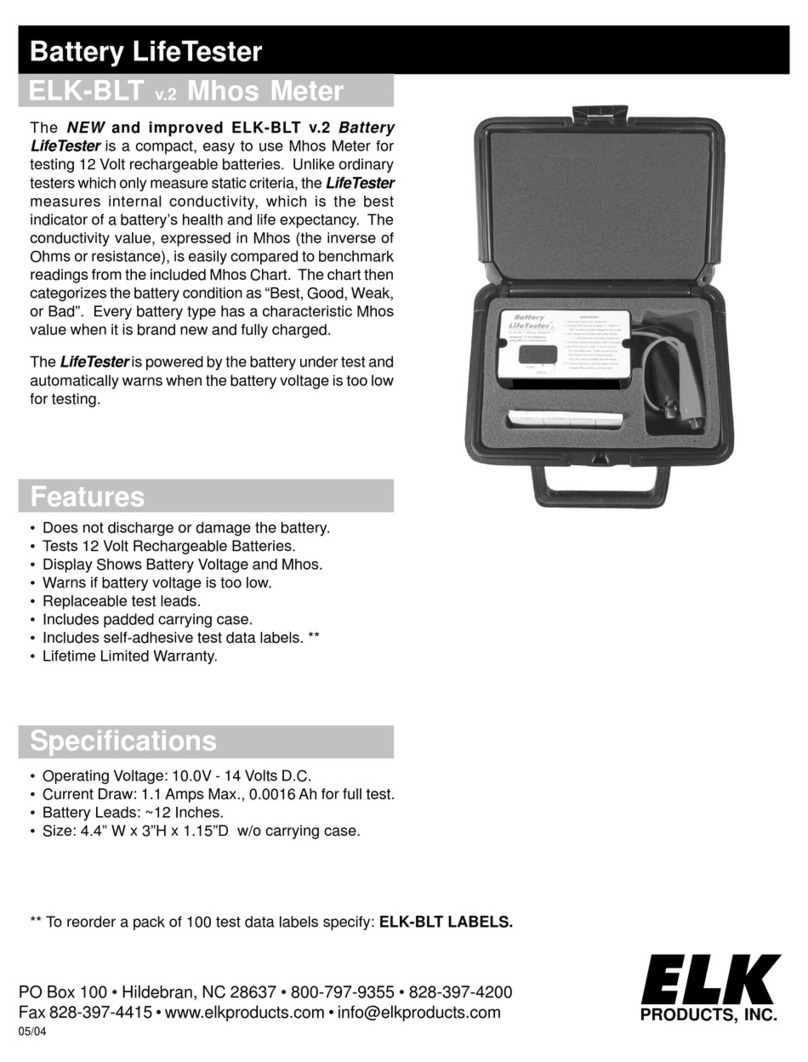
Elk Products
Elk Products Battery LifeTester ELK-BLT instruction manual
